The Genus Fuchsia
Section Encliandra
(six species)
This section occurs in the temperate and cool temperate oak-pine forests of Mexico south of the Tropic of Cancer to Panama at elevations from 1,500 to 3,400 meters. They are all shrubs with opposite leaves. The solitary, axillary flowers have floral tubes 0.1 to 1.3 cm long with smooth to lobed nectaries. The sepals are erect to reflexed and colored purplish red, pink, or white with the petals being purplish red, red, pink, or white. The stamens are in two unequal to sub-equal series. The epipetalous set is reflexed into the floral tube and the pollen is yellow. Seeds number six to thirty-six.
This section's name derives from the Greek encliandra, for "enclosed male," referring to the fact that the flower's stamens are enclosed within the floral tube. Encliandra parviflora was fist described by Zuccarini in 1837. However that genus and it species were shorty rendered synonymous with Fuchsia as Fuchsia encliandra by Steudel in 1840, three years later. The defunct designation was later applied to the section in which Encliandra is now at home.
Name: Fuchsia sect. Encliandra (Zucc.) Lindm., 1838.
Typus: F. encliandra Steud.
Synonyms
Homotypic
Encliandra Zucc., Abh. Math.-Phys. Cl. Königl. Bayer. Akad. Wiss. 2: 335. 1837.
Eucliandra Steud., Nom., ed 2, 1: 600. 1840, sphalm.
Heterotypic
Brebissonia Spach, Ann. Sci. Nat., Bot. sér. 2, 4: 175. 1835.
Myrinia Lilja, Fl. Sverig. Suppl. 1. 25. 1840.
Lyciopsis Spach, Ann. Sci. Nat., Bot. sér. 2, 4: 176. 1835.
Section Encliandra
(six species)
This section occurs in the temperate and cool temperate oak-pine forests of Mexico south of the Tropic of Cancer to Panama at elevations from 1,500 to 3,400 meters. They are all shrubs with opposite leaves. The solitary, axillary flowers have floral tubes 0.1 to 1.3 cm long with smooth to lobed nectaries. The sepals are erect to reflexed and colored purplish red, pink, or white with the petals being purplish red, red, pink, or white. The stamens are in two unequal to sub-equal series. The epipetalous set is reflexed into the floral tube and the pollen is yellow. Seeds number six to thirty-six.
This section's name derives from the Greek encliandra, for "enclosed male," referring to the fact that the flower's stamens are enclosed within the floral tube. Encliandra parviflora was fist described by Zuccarini in 1837. However that genus and it species were shorty rendered synonymous with Fuchsia as Fuchsia encliandra by Steudel in 1840, three years later. The defunct designation was later applied to the section in which Encliandra is now at home.
Name: Fuchsia sect. Encliandra (Zucc.) Lindm., 1838.
Typus: F. encliandra Steud.
Synonyms
Homotypic
Encliandra Zucc., Abh. Math.-Phys. Cl. Königl. Bayer. Akad. Wiss. 2: 335. 1837.
Eucliandra Steud., Nom., ed 2, 1: 600. 1840, sphalm.
Heterotypic
Brebissonia Spach, Ann. Sci. Nat., Bot. sér. 2, 4: 175. 1835.
Myrinia Lilja, Fl. Sverig. Suppl. 1. 25. 1840.
Lyciopsis Spach, Ann. Sci. Nat., Bot. sér. 2, 4: 176. 1835.

F. encliandra Steud. (3 subspecies)
Synonyms—; Encliandra parviflora, Zuccarini 1837; F. parviflora, Hemsley 1828.
Herbarium Specimens—Field Museum.
F. encliandra subsp. encliandra (Zucc.) Steud.
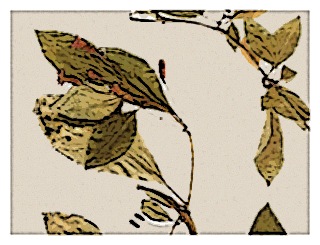 Mexico. Common in forests of pine, oak and arbutus from the Sierra Madre of southern Jalisco State south to central Oaxaca and from the Sierra Madre Oriental of southern San Luis Potosí south through Morelos and Puebla to the Sierra Juárez, Oaxaca at elevations from 1,800 to 2,600 meters.
Mexico. Common in forests of pine, oak and arbutus from the Sierra Madre of southern Jalisco State south to central Oaxaca and from the Sierra Madre Oriental of southern San Luis Potosí south through Morelos and Puebla to the Sierra Juárez, Oaxaca at elevations from 1,800 to 2,600 meters.
Habit—Shrub 0.5 to 2 m tall; branchlets 35 to 55 cm long, 0.5 to 3 mm thick; older branches 3 to 25 mm thick.
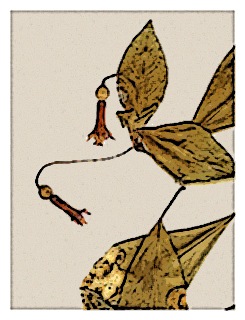
Leaves—Elliptic to narrowly ovate, 9 to 27 mm long, 4 to 17 mm wide, glabrous to puberulent on both surfaces; base cuneate to attenuate; apex acute to short acuminate; petiole 1 to 9 mm long.
Flowers—Staminate flowers, pedicels 9 to 20 mm long, hypanthium 7 to 12 mm long, 2 to 3.3 mm wide at rim, 1.8 to 3 mm wide at base, glabrous to pubescent outside, sepals 2.7 to 4.5 mm long, 1.6 to 2.6 mm wide at base, petals 2.2 to 4 mm long, 1.8 to 2.8 mm wide, nectary 1.6 to 1.9 mm high. Pistillate flowers, pedicels 8 to 10 mm long, hypanthium 4.5 to 7.3 mm long, 1.5 to 2.5 mm wide at rim, 1.4 to 2.4 mm wide at base, sepals 2.4 to 3.6 mm long, 0.8 to 1.6 mm wide at base, petals 1.2 to 2 mm long, 0.7 to 1.2 mm wide, nectary 0.4 to 0.6 mm high, style 6.5 to 12.5 mm long, the stigma exserted 2 to 3.8 mm above the rim of the hypanthium, its lobes 0.7 to 1 mm long.

Seeds—Seeds, 6 to 18, 2.1 to 3.4 mm long, 1.1 to 2.7 mm thick.
Chromosomes: Gametic chromosome number n = 11.
Author—Steudel 1840.
Original publication—Nomencl. Bot. ed. 2, 1: 649 1840.
Synonyms—F. acynifolia, Scheidweiler 1847.
Herbarium Specimens—None known on-line.
F. encliandra subsp. microphylloides P.E.Berry & Breedlove
Mexico. Abundant in wet pine-oak forests and in cloud forests along the crest of the Sierra Madre of Guerrero, Michoacán, and Oaxaca, in Mexico. It is mainly found above 2,000 meters in elevation, usually between 2,200 and 2,500 meters, but can occasionally range up to 3,000 meters.
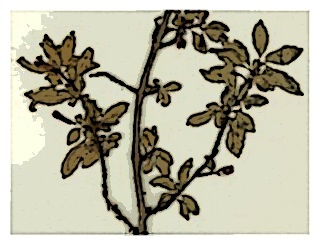
Habit—Shrub 1 to 2 m tall, dioecious; branchlets 4 to 18 cm long, emerging at a + 90' angle from the main stem, subglabrous to finely appressed-pubescent with tan hairs 0.2 to 0.4 mrn long.
Leaves—Opposite, firmly membranous, the blade lance-elliptic, 15 to 40 (to 50) mm long, 7 to 15 mm wide, glabrous on both sides or sometimes with fine appressed hairs along veins or margins on lower surface, secondary veins 4 to 6 on either side of the midvein or sometimes inconspicuous, apex acute, base attenuate. margin subentire to serrulate. sometimes + revolute; petiole 4 to 10 mm long; stipules narrowly lanceolate, dark brown. ca. 0.3 mm wide, 0.5 to 0.7 mm long, deciduous.
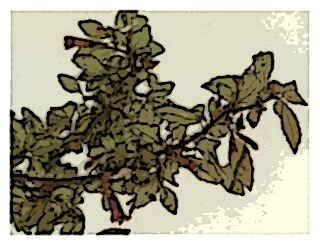
Flowers—Staminate flowers, pedicels 5 to 22 mm long, floral tube cylindrical, glabrous, magenta, 9 to 11 mm long, 2 to 4 mm wide at the rim, 1.5 to 2 mm wide at the base, sepals triangular, 3 to 4 mm long, 2 to 2.5 mm wide at the base, spreading, the apex shortly acuminate, petals magenta, subrotund, 2 to 3 mm long, 2 to 3 mm wide, slightly three-lobed at the apex, nectary 0.9 to 11 mm high, entire, style 6 to 10 mm long, included within the floral tube, the stigma inconspicuous, aborted, antesepalous stamens exserted above the rim of the tube, antepetalous ones included inside the floral tube, filaments 1.0-1.5 mm long, anthers oblong 1.6 to 2.0 mm long, 0.7 to 1.0 mm thick. Pistilate flowers, pedicels 4 to 7 mm long, ovary spherical circa 2 mm in diameter, floral tube narrowly cylindric, 5 to 7 mm long, 2 to 2.5 mm wide at the rim, ca. 1mm wide at the base, sepals triangular, 2.5 mm long, 1.5 to 2 mm wide at the base, petals 1.3 to 2 mm long, 1 to 1.3 mm wide, sterile anthers oblong, 0.5 to 0.8 mm long, filaments 0.2 to 0.6 mm long, nectary 0.5 to 0.8 mm high, style 7 to 9 mm long, the stigma exserted 1.5 to 2.5 mm beyond the rim of the tube, its lobes ca. 1 mm long.
long, nectary 0.5 to 0.8 mm high, style 7 to 9 mm long, the stigma exserted 1.5 to 2.5 mm beyond the rim of the tube, its lobes ca. 1 mm long.
Fruit—The berry is subglobose and 4 to 5.5 mm in diameter.
Seeds: The seeds are 12 to 18, 1.5 to 2.0 mm long, and 0.9 to 1.1 mm thick.
Chromosomes: Gametic chromosome number n = 11. [Not verified?]
Authors—P.E.Berry & Breedlove 1996.
Original publication—Novon 6(2): 139, f. 3. 1996.
Synonyms—None.
Herbarium Specimens—Missouri.
F. encliandra ssp. tetradactyla (Lindl.) Breedlove
Mexico & Central America. Locally abundant in forests of pine, oak and arbutus in scattered localities from central Chiapas, Mexico, through Guatemala, El Salvador, Honduras, and northern Nicaragua at elevations from1,500 to 2,400 meters.
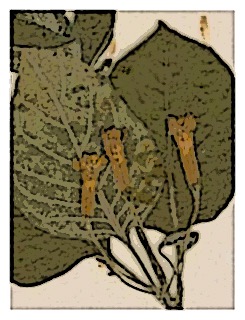
Habit—Shrub 0.8 to 2.5 m tall; branchlets 25 to 55 cm long, 2.5 to 5 mm thick; older branches 5 to 35 mm thick.
Leaves—Elliptic to broadly ovate, 22 to 110 mm long, 8 to 50 mm wide, strigulose on both surfaces; base obtuse to attenuate; apex acute to acuminate; petiole 10 to 35 mm long.
Flowers—Staminate flowers, pedicels 8 to 20 mm long, hypanthium. 6.3 to 7.8 mm long, 2.8 to 3.1 mm wide at rim, 2.4 to 2.8 mm wide at base, sepals 2.8 to 4.6 mm long, 1.8 to 2.4 mm wide at base, petals 2.5 to 3.7 mm long, 1.8 to 2.4 mm wide , nectary 1.4 to 1.7 mm high. Pistillate flowers, pedicels 8 to 12 mm long, hypanthium 3.8 to 6 mm long, 1.2 to 1.8 mm wide at rim, 1.1 to 1.3 mm wide at base, sepals 2.1 to 2.7 mm long, 0.7 to 1.4 mm wide at base, petals 1.4 to 1.8 mm long, 0.9 to 1.1 mm wide, nectary 0.9 to1.1 mm high, style 6 to 9.5 mm long, the stigma exserted 3.5 to 5 mm above the rim of the hypanthium, its lobes 0.7 to 1.2 mm long,
Seeds—Seeds number 6 to 8, 2.5 to 3.4 mm long, 2 to 2.7 mm thick.

Chromosomes: Gametic chromosome number n 11.
Authors—(Lundell) Breedlove 1969.
Original publication—Univ. Calif. Publ. Bot. 53: 53 1969.
Synonyms—Fuchsia tetradactyla, Lindley 1846; F. seleriana, Loesener 1913; F. striolata, Lundell 1940.
Herbaria—California Academy 1, California Academy 2; Field Museum; Kew; Missouri; Smithsonian 1, Smithsonian 2; Texas.
F. microphylla Kunth (6 subspecies)
Authors—Humboldt, Bonpland & Kunth 1823
Original publication—Nov. Gen. Sp. 6: 103 1823.
Herbarium Specimens—Arizona State 1, Arizona State 2; Field Museum; Texas 1, Texas 2, Texas 3, Texas 4, Texas 5.
F. microphylla subsp. aprica (Lundell) Breedlove
Mexico. Common in dense forests of fir and oak and evergreen cloud forests from the central highlands and the Sierra Madre del Sur of Chiapas State south through Guatemala, El Salvador, and scattered locations in Honduras at elevations from 1,500 to 3,500 meters.
Habit—Shrub 1 to 3 m tall; branchlets 5 to 18 cm long, subglabrous to canescent with white hairs; older branches 5 to 23 mm thick.
Leaves—Chartaceous to coriaceous, narrowly lanceolate to broadly elliptic, 1.2 to 3.8 mm long, 0.6 to 2.8 mm wide, glabrous to pubescent on the margins and veins; base acute to attenuate; apex acute to naucronate; petiole 1.3 to 15 mm long.
Flowers—Perfect flowers, pedicels 6 to 15 mm long, hypanthium subcylindric to cylindric, 6.5 to 12.8 mm long, 2.5 to 4.2 mm wide at rim, 2.2 to 3.2 mm wide at base, glabrous to heavily pubescent, sepals 3.5 to 6.2 mm long, 1.8 to 3 mm wide at base, spreading to suberect, the apex acute to long acuminate, hypanthium and sepals red to purplish-red, petals red to pale purplish-red, 2.8 to 4.8 mm long, 2 to 4.5 mm wide, the apex rounded to emarginate, slightly pubescent on the outer surface, nectary entire, 0.8 to 1.2 mm high, episepalous stamens exserted 0.6 to 2.4 mm above the rim of the hypanthium, filaments equal 1.3 to 1.6 mm long, anthers 1.4 to 1.7 mm long, 0.6 to 0.8 mm thick, style 8.8-17.7 mm long, the stigma exserted 2.5 to 7.9 mm above the rim of the hypanthium, its lobes suberect, 0.4 to 0.7 mm long. Pistillate flowers, pedicels 4 to 12 mm long, hypanthium 3.5 to 5.8 mm long, 1.4 to 1.8 mm wide at rim, 1.0 to 1.5 mm wide at base, sepals 2.8 to 3.9 mm long, 1.2 to 1.6 mm wide at base, petals 1 to 1.7 mm long, 0.5 to 1.2 mm wide, nectary 0.5 to 0.7 mm high, style 5.6 to 7.8 mm long, the stigma exserted 1.6 to 2.7 mm above the rim of the hypanthium, its lobes 0.7 to 0.9 mm long.
Seeds—Seeds 14 to 24, 1.9 to 2.4 mm long, 0.9 to 1.2 mm thick.
Chromosomes—Gametic chromosome number n =11, 22.
Authors—(Lundell) Breedlove 1969.
Original publication—Univ. Calif. Publ. Bot. 53: 45 1969.
Synonyms—F. aprica, Lundell 1940; F. microphylla var. aprica, (Lundell) Munz 1943.
Herbarium Specimens—MIssouri; New York; Smithsonian.
F. microphylla subsp. chiapensis (Brandegee) P.E.Berry & Breedlove
Mexico. In the mountains of southwestern Chiapas State (Sierra de Soconusco) in Mexico and in scattered localities along the Pacific slope of Guatemala and El Salvador in montane rainforest, evergreen cloud forest, and wet pine-oak forest at elevations from 1,800 and 2,400 meters.
Habit—Shrub 1 to 2 m tall, gynodioecious; branchlets 5 to 15 cm long, lightly to densely strigose with tan to white hairs.
Leaves—Opposite, membranous, the blade elliptic-ovate, 15 to 40(-50) mm long, 8 to 23 (to 30) mm wide, with scattered hairs on the lower surface along the veins, secondary veins 4-6 on mm wide at the base.
Flowers—Sepals 2.5 to 4 mm long, 1.5 to 2.5 mm wide at the base, spreading, the apex subacuminate, petals red, 2 to 3 mm long, 2 to 4 mm wide, three-lobed at the apex, nectary 0.7 to 1.2 mm high, entire: style 8 to 12 mm long, the stigma capitate, exserted 3 to 6 mm beyond the rim of the tube: antesepalous stamens exserted above the rim of the tube, antepetalous ones included inside the floral tube, filaments 0.5 to 1.5 mm long: anthers 1.4 to 2.0 mm long, 0.7 to 1.0 mm thick, Female flowers, pedicels 6 to 20 mm long, floral tube cylindric-obconic, 4 to 6 mm long, 2 to 2.5 mm wide at the rim, circa 1mm wide at the base, sepals narrowly triangular. 3 to 5 mm long. 1.5 to 2 mm wide at the base, petals 0.7 to 2 mm long, 0.7 to 1.7 mm wide: sterile anthers oblong, 0.5 to 1 mm long, filaments 0.3 to 0.8 mm long, nectary 0.5 to 0.8 mm high, style 7 to 8 mm long, the stigma exserted 1.5 to 2.5 mm beyond the rim of the tube its lobes circa 1 mm long.
Fruit—Fruit subglobose, 5 to 7 mm diameter.
Seeds—Seeds 12 to 20, 1.9 to 2.4 mm long, 1 to 1.3 mm thick.
Chromosomes—Gametic chromosome number n = 11. [Not verified?]
Authors—(Brandegee) P.E.Berry & Breedlove 1996.
Original publication—Novon 6: 137 1996.
Synonyms—F. chiapensis, Brandegee 1914; F. heterotricha, Lundell 1940.
Herbarium Specimens—Smithsonian 1, Smithsonian 2.
F. microphylla subsp. hemsleyana (Woodson & Seibert) Breedlove
Costa Rica & Panama. Common in the understory of evergreen cloud forests on the high volcanos of Costa Rica and northern Panama at elevations from 1,500 to 3,100 meters.
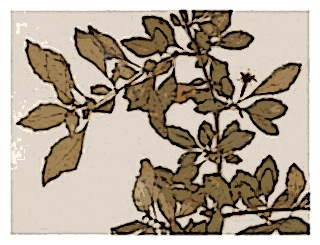 Habit—Shrub 1 to 4 m tall, occasionally epiphytic, branchlets 5 to 30 cm long, canescent with white hairs, older branches 5 to 25 mm thick.
Habit—Shrub 1 to 4 m tall, occasionally epiphytic, branchlets 5 to 30 cm long, canescent with white hairs, older branches 5 to 25 mm thick.
Leaves—Subcoriaceous, lanceolate to elliptic, 0.2-30 mm long, 6-12 mm wide, entire to serrate, the margins and main veins ciliate; base attenuate; apex acute to acuminate ; petiole 4-15 mm long.
Flowers—Perfect flowers, pedicels 5 to 11 mm long, hypanthium subcylindric, 7 to 11 mm long, 2.4 to 3.7 mm wide at rim, 1.4 to 2.5 mm wide at base, pubescent, sepals 3.5 to 5.2 mm long, 1.4 to 2.6 wide at base, reflexed to spreading, the apex acuminate to caudate, hypanthium and sepals red, petals red, 1.6 to 2.4 mm long, 1.4 to 1.7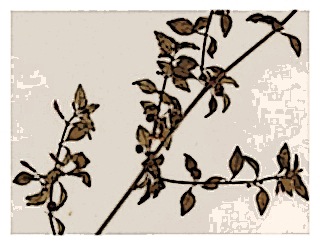 mm wide, the apex rounded, puberulent, nectary entire, 0.9 to 1.2 mm long, episepalous stamens exserted 1.2 to 1.6 mm above the rim of the hypanthium, filaments unequal, the episepalous ones 0.8 to 1 mm long, the epipetalous ones 1.2 to 1.5 mm long, anthers 1.2 to 1.6 mm long, 0.5 to 0.7 mm thick, style 12.5 to 19.2 mm long, the stigma exserted 3.5 to 8 mm above the rim of the hypanthium, its lobes suberect, 0.5 to 0.9 mm long. Pistillate flowers, pedicel 4 to 9 mm long; hypanthium 3.4 to 4.6 mm long, 1.1 to 1.6 mm wide at rim, 0.8 to 1.1 mm wide at base; sepals 2.8 to 3.6 mm long, 0.9 to 1.2 mm wide at base ; petals 0.7 to 1.2 mm long, 0.4 to 0.8 mm wide; nectary 0.7 to 0.9 mm high; style 5.2 to 6.1 mm long, the stigma exserted 1.5 to 2.3 mm above the rim of the hypanthium, its lobes 0.8 to 1.2 mm long.
mm wide, the apex rounded, puberulent, nectary entire, 0.9 to 1.2 mm long, episepalous stamens exserted 1.2 to 1.6 mm above the rim of the hypanthium, filaments unequal, the episepalous ones 0.8 to 1 mm long, the epipetalous ones 1.2 to 1.5 mm long, anthers 1.2 to 1.6 mm long, 0.5 to 0.7 mm thick, style 12.5 to 19.2 mm long, the stigma exserted 3.5 to 8 mm above the rim of the hypanthium, its lobes suberect, 0.5 to 0.9 mm long. Pistillate flowers, pedicel 4 to 9 mm long; hypanthium 3.4 to 4.6 mm long, 1.1 to 1.6 mm wide at rim, 0.8 to 1.1 mm wide at base; sepals 2.8 to 3.6 mm long, 0.9 to 1.2 mm wide at base ; petals 0.7 to 1.2 mm long, 0.4 to 0.8 mm wide; nectary 0.7 to 0.9 mm high; style 5.2 to 6.1 mm long, the stigma exserted 1.5 to 2.3 mm above the rim of the hypanthium, its lobes 0.8 to 1.2 mm long.
Fruit—Fruit with 16 to 24 seeds, seeds 2 to 2.1 mm long, 0.9 to 1.1 mm thick.
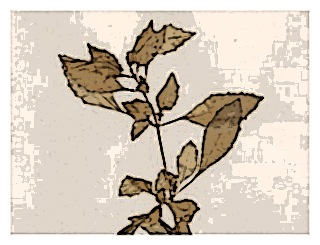
Chromosomes—Gametic chromosome number, n = 11.
Authors—(Woodson & Seibert) Breedlove 1969.
Original publication—Univ. Calif. Publ. Bot. 53: 47 1969.
Synonyms—F. hemsleyana, Woodson & Seibert 1937; F. pulchella, Woodson & Seibert 1937.
Herbarium Specimens—Kew; California Academy; MIssouri 1. Missouri 2; New York,
F. microphylla subsp. hidalgensis (Munz) Breedlove
Central Mexico. Scattered to rare in mixed evergreen forests of pine and oak in southeastern Hidalgo and northern Puebla states from 1,600 to 2,200 meters in elevation.
Habit—Shrub 0.5 to 2 m tall; branchlets 5 to 30 cm long, canescent with brown hairs; older branches 5 to 15 mm thick.
Leaves—Subcoriaceous, lanceolate to narrowly oblanceolate, 6 to 25 mm long, 4 to 10 mm wide, serrate from the apex for about three-quarters of the margin, 4 to 12 teeth on each side, ciliate on the margins and veins; base attenuate; apex acute to mucronate; petiole 0.5- to mm long.
Flowers—Perfect flowers, pedicels 3 to 8 mm long, hypanthium narrowly obconic, 4.2 to 5.6 mm long, 1.73 mm wide at rim, 0.5 to 1.2 mm wide at base, subglabrous to puberulent, sepals 3.8 to 5.2 mm long, 1.2 to 1.8 to 2 mm wide, rotund, apex rounded, glabrous to puberulent, nectary deeply four-lobed, 0.6 to 0.8 mm high, episepalous stamens exserted 0.8 to 1.1 mm above the rim of the hypanthium, filaments equal, 0.6 to 0.9 mm long, anthers 1 to 1.4 mm long, 0.4 to 0.6 mm thick, style 9.2 to 10.9 mm long, the stigma exserted 3.5 to 5.6 mm above the rim of the hypanthium, its lobes spreading, 0.9 to 1.1 mm long. Pistillate flowers, pedicels 1 to 3 mm long, hypanthium 2.2 to 3.6 mm long, 1.3 to 1.8 mm wide at rim, 0.3 to 0.8 mm wide at base, sepals 2 to 3.2 mm long, 0.9 to 1.2 mm wide at base, petals 1.2 to 1.5 mm long, 0.8 to 1.2 mm wide, nectary 0.3 to 0.5 mm high, style 4.6 to 5.8 mm long, the stigma exserted 1 to 1.8 mm above the rim of the hypanthium, its lobes 0.9 to 1.2 mm long.
Seeds—25 to 36 seeds per berry, 1 to 1.2 mm long, 0.5 to 0.7 mm thick.
Chromosomes: Gametic chromosome number n = 11.
Authors—(Munz) Breedlove 1969.
Original publication—Univ. Calif. Publ. Bot. 53: 43 1969.
Synonyms—F. minutiflora, Hemsley; var. hidalgensis, Munz 1943.
Herbarium Specimens—Arizona State 1, Arizona State 2, Arizona State 3; Edinburgh; Kew; New York; Smithsonian.
F. microphylla subsp. microphylla (Kunth) Breedlove
Mexico. 2100-3200 m. In forests of pine, oak, and fir on the higher slopes of the Trans-Mexican Volcanic Belt from Jalisco to Vera Cruz, also in fir and evergreen cloud forests on isolated high mountains of the Sierra Madre Oriental of Hidalgo, the Sierra Madre of Guerrero and the Sierra de Zempoaltepetl of Oaxaca at elevations from 2,100 to 3,200 meters.
Habit—Shrub 0.5 to 3 m tall; branchlets 5 to 15 cm long, subglabrous or canescent with white or brown hairs; older branches 5 to 20 mm thick.
Leaves—Coriaceous, narrowly elliptic to elliptic, 8 to 30 (to 40) mm long, 4 to 12 mm wide, serrate from the apex to the middle, entire from the middle to the base, glabrous to ciliate on the margins; base attenuate; apex acute to mucronate; petiole 0.5 to 7 mm long.
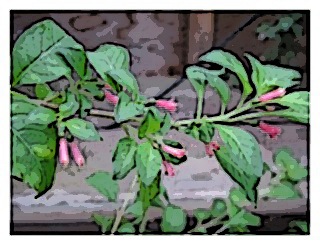
Flowers—Perfect flowers, pedicels 6 to 12 mm long, hypanthium subcylindric to cylindric, 7 to 10.5 mm long, 2.9 to 4.2 mm wide at rim, 1.8 to 2.6 mm wide at base, glabrous or with a few scattered hairs outside, sepals 3.5 to 6 long, 2.2 to 2.8 mm wide at base, spreading, the apex mucronate to long acuminate, hypanthium and sepals purplish-red, petals pale purplish-red, 3.5 to 5.8 mm long, 2.5 to 4.4 mm wide, the apex emarginate, slightly pubescent on the outer surface, nectary entire, 1.1 to 1.4 mm high, episepalous stamens exserted 1.4 to 2.4 mm above the rim of the hypanthium, filaments unequal, the episepalous ones 0.9 to 1.3 mm long, the epipetalous ones 1.5 to 1.9 mm long, anthers 1.2 to 1.7 mm long, 0.5 to 0.8 mm thick, style 11.4 to 17.2 mm long, the stigma exserted 4.2 to 7.5 mm above the rim of the hypanthium, its lobes spreading, 0.4 to 0.7 mm long. Pistillate flowers, pedicels 4 to 10 mm long, hypanthium 3 to 6.5 mm long, 1.4 to 2.6 mm wide at rim, 1.2 to 2 mm wide at base, sepals 2.3 to 4 mm long, 1 to 2.1 mm wide at base, petals 1.6 to 3 mm long, 0.8 to 1.8 mm wide, nectary 0.7 to 0.9 mm high, style 5.4 to 8.6 mm long, the stigma exserted 1.5 to 3 mm above the rim of the hypanthium, its lobes 0.8 to 1.3 mm long.
Seeds—Seeds 12 to 18, 1.8 to 2.6 mm long, 0.9 to 1.2 mm thick.
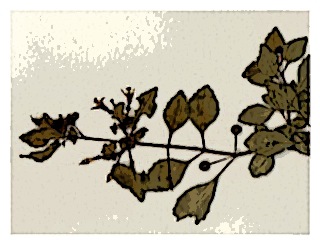
Chromosomes—Gametic chromosome number n = 11.
Authors—Breedlove 1969.
Original publication—Nov. Gen. Sp. 6: 103 1823.
Synonyms—Hemsley 1878; F. minutiflora var. typica, Munz 1943; F. mixta, Hemsley 1878; F. notarsii, Lehmann 1852; F. uniflora, Sesse & Mociño 1888; Myrinia microphylla, (H. B. K.) Lilja 1840.
Herbarium Specimens—Kew 1, Kew 2; California Academy.
F. microphylla subsp. quercetorum (Kunth) Breedlove
Mexico & Guatemala. In open forests with pintas, oak and sweet gum from the central highlands of Chiapas State in Mexico south to the Sierra las Minas in Guatemala at elevations from 1,500 to 2,200 meters.
Habit—Shrub 0.5 to 2.5 m tall; branchlets 5 to 20 cm long, glabrous to canescent, with white hairs; older branches 5 to 30 mm thick.
Leaves—Subcoriaceous to coriaceous, elliptic to broadly lanceolate, 6 to 30 mm long, 3 to 14 mm wide, entire, re-volute, glabrous to pubescent on. the margins and veins; base acute to attenuate; apex acute; petiole 3 to 8 mm long.
Flowers—Perfect flowers, pedicels 8 to 16 mm long, hypanthium cylindric, 6 to 8.5 mm long, 1.9 to 2.3 mm wide at rim, 1.7 to 2.1 mm wide at base, subglabrous to puberulent, sepals 1.9 to 2.8 mm long, 1.6 to 2.3 mm)(vide at base, spreading to suberect, the apex acute to acuminate, hypanthium and sepals red, petals red, 1.5 to 2.6 mm long, 1.2 to 2.1 mm wide, the apex rounded, puberulent on the outer surface, nectary entire, 1 to 1.5 mm high, episepalous stamens exserted 0.7 to 1 mm above the rim of the hypanthium, filaments equal, 0.8 to 1 mm long, anthers 1 to 1.3 mm long, 0.5 to 0.6 mm thick, style 8.4 to 12.8 mm long, the stigma exserted 2.8 to 5 mm above the rim of the hypanthium, its lobes spreading, 0.4 to 0.7 mm long. Pistillate flowers pedicels 4 to 8 mm long, hypanthium 2.6 to 4 mm long, 1.4 to 1.8 mm wide at rim, 1.3 to 1.6 mm wide at base, sepals 1.2 to 1.9 mm long, 0.9 to 1.2 mm wide at base, petals 0.8 to 1 mm long, 0.6 to 0.8 mm wide, nectary 0.7 to 0.9 mm high, style 4.8 to 6.4 mm long, the stigma exserted 1.8 to 2.4 mm above the rim of the hypanthium, its lobes 0.8 to 1.2 mm long.
Seeds—Seeds 12 to 18, 1.7 to 2.4 mm long, 0.9 to 1.1 mm thick.
Chromosomes—Gametic chromosome number n =11.
Authors—Breedlove 1969.
Original publication—
Synonyms—None.
Herbarium Specimens—California Academy.
F. obconica Breedlove
Mexico. Abundant in forests of pine and oak in scattered localities on the lower mountains of the Trans-Mexican Volcanic Belt from Jalisco to Morelos States in Mexico at elevations from 1,700 to 2,400 meters.
Volcanic Belt from Jalisco to Morelos States in Mexico at elevations from 1,700 to 2,400 meters.
Habit—Dioecious. Erect shrub, 1 to 3 m tall; branchlets ascending, vigorous, 20 to 60 cm long, 0.5 to 3 mm thick, quadrangular in transection, sparsely to densely canescent; older branches 15 to 35 mm thick.
Leaves—Opposite to subopposite, chartaecous to subcoriaceous, lanceolate or oblanceolate to broadly elliptic, 11 to 63 mm long, 6 to 24 mm wide, serrate, glabrous to sparsely puberulent on the upper surface, pubescent on the margin and veins below; base obtuse to cuneate; apex acute; petiole pubescent, 3 to 29 mm long.
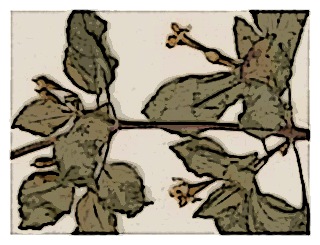
Flowers—Staminate flowers, pedicels spreading to drooping, pubescent, 4 to 7 mm long, hypanthium obconic, 4.8 to 7.7 mm long, 1.8 to 2.6 mm wide at rim, 0.9 to 1.6 mm wide at base, pubescent outside, villous pubescent on the lower third inside, sepals lanceolate, 2.4 to 3.2 mm long, 1.2 to 1.8 mm wide at base, reflexed, the apex acuminate to cuspidate, the tips connivent in bud, hypanthium and sepals greenish-white to white, petals white, elliptic to rotund, 2.1 to 2.8 mm long, 1.9 to 2.5 mm wide, glabrous to sparsely puberulent, spreading, apex rounded, nectary a deeply four-lobed swollen disc, 0.5 to 0.8 mm high, episepalous stamens exserted 0.9 to 1.3 mm above the rim of the hypanthium, filaments equal, 0.7 to 1 mm long, anthers 1.2 to 1.5 mm long, 0.4 to 0.6 mm thick, style filiforma, 2.4 to 4.6 mm long, stigma usually undeveloped, ovary undeveloped. Pistillate flowers, similar to the staminate in all except the following: pedicels 3 to 5 mm long, hypanthium subcylindric to obconic, 1.8 to 3.8 mm long, 1 to 1.5 mm wide at rim, 0.8 to 1.2 mm wide at base, sepals 0.9 to 1.6 mm long, 0.6 to 0.8 mm wide at base, petals 0.6 to 1 mm long, 0.3 to 0.6 mm wide, nectary 0.4 to 0.6 mm high, style 3.5 to 6 mm long, the stigma exserted 1.6 to 3.3 mm above the rim of the hypanthium, its lobes broadly lanceolate, suberect, 0.9 to 1.3 mm long,
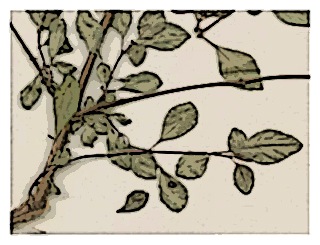
Seeds—Seeds 12 to 16, 2.1 to 2.6 mm long, 0.9 to 1.1 mm thick, oblanceolate to elliptic in outline, hilum subbasal.
Chromosomes: Gametic chromosome number n = 11.
Authors—Breedlove 1969.
Original publication—Univ. Calif. Publ. Bot. 53: 54 1969.
Synonyms—None.
Herbarium Specimens—Field Museum; Kew 1, Kew 2; California Academy 1, California Academy 2; Smithsonian.
F. parviflora Lindl.
Mexico. Scattered in canyons with forests of pine, oak and arbutus and in evergreen cloud forests from the Sierra Madre Occidental of southwestern Durango through the western part of the Trans-Mexican Volcanic Belt of Jalisco, Michoacán, and México to the Sierra Madre of Guerrero at elevations from 1,500 to 2,500 meters.

Habit—Dioecious. Erect shrub, 1.5 to 4 m tall; branchlets ascending, vigorous, 3 to 6.5 dm long, 0.5 to 6 mm thick, somewhat quadrangular in transection, subglabrous to loosely villous pubescent with white wavy hairs. Older branches are 15 to 55 mm thick.
Leaves—Opposite, chartaceous, oblanceolate to ovate, 30 to 75 mm long, strigose pubescent on both surfaces; base cuneate to attenuate; apex acute to apiculate; petiole pubescent, 8 to 45 mm long.
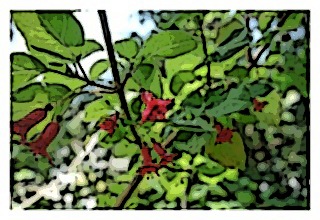 Flowers—Staminate flowers, pedicels spreading to ascending, pubescent, 12 to 23 mm long, hypanthium cylindric, 8.5 to 11.2 mm long, 3.5 to 3.8 mm wide at rim, 3.2 to 3.5 mm wide at base, pubescent outside, densely villous pubescent on the inside lower half , sepals broadly lanceolate, 2.8 to 5.3 mm long, 2.1 to 2.8 mm wide at base, spreading to suberect, the apex acute to acuminate, the tips connivent in bud, hypanthium red, sepals red or white, petals red or white, rotund, 3.2 to 4 mm long, 2.5 to 3.2 mm wide, puberulent, spreading to erect, apex rounded, nectary a swollen disc, 1.8 to 2.1 mm high, episepalous stamens exserted 0.8 to 1.3 mm above the rim of the hypanthium, filaments unequal, the episepalous ones 0.6 to 0.7 mm long, the epipetalous ones 0.9 to 1.1 mm long, anthers 1.4 to 1.9 mm long, 0.5 to 0.6 mm thick, style filiform, 3 to 6 mm long, stigma usually undeveloped , ovary undeveloped. Pistillate flowers–Similar to the staminate ones in all except the following characteristics: pedicels 9 to 15 mm long, hypanthium 3.2 to 5.7 mm long, 1.7 to 2.5 mm wide at rim, 1.2 to 2.3 mm wide at base, sepals 2.7 to 4.2 mm long, 1.2 to 1.8 mm wide at base, petals 1.5 to 2.1 mm long, 0.8 to 1.2 mm wide, nectary 0.7 to 0.9 mm high, style 5.7 to 8.2 mm long, the stigma exserted 2.5 to 3.5 mm above the rim of the hypanthium, its lobes lanceolate, spreading, 0.8 to 1.3 mm long,
Flowers—Staminate flowers, pedicels spreading to ascending, pubescent, 12 to 23 mm long, hypanthium cylindric, 8.5 to 11.2 mm long, 3.5 to 3.8 mm wide at rim, 3.2 to 3.5 mm wide at base, pubescent outside, densely villous pubescent on the inside lower half , sepals broadly lanceolate, 2.8 to 5.3 mm long, 2.1 to 2.8 mm wide at base, spreading to suberect, the apex acute to acuminate, the tips connivent in bud, hypanthium red, sepals red or white, petals red or white, rotund, 3.2 to 4 mm long, 2.5 to 3.2 mm wide, puberulent, spreading to erect, apex rounded, nectary a swollen disc, 1.8 to 2.1 mm high, episepalous stamens exserted 0.8 to 1.3 mm above the rim of the hypanthium, filaments unequal, the episepalous ones 0.6 to 0.7 mm long, the epipetalous ones 0.9 to 1.1 mm long, anthers 1.4 to 1.9 mm long, 0.5 to 0.6 mm thick, style filiform, 3 to 6 mm long, stigma usually undeveloped , ovary undeveloped. Pistillate flowers–Similar to the staminate ones in all except the following characteristics: pedicels 9 to 15 mm long, hypanthium 3.2 to 5.7 mm long, 1.7 to 2.5 mm wide at rim, 1.2 to 2.3 mm wide at base, sepals 2.7 to 4.2 mm long, 1.2 to 1.8 mm wide at base, petals 1.5 to 2.1 mm long, 0.8 to 1.2 mm wide, nectary 0.7 to 0.9 mm high, style 5.7 to 8.2 mm long, the stigma exserted 2.5 to 3.5 mm above the rim of the hypanthium, its lobes lanceolate, spreading, 0.8 to 1.3 mm long,
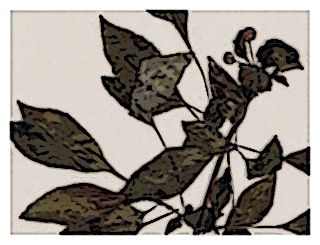 Seeds—Number 14 to 20 per berry, 1.9 to 2.3 mm long, 1.1 to 1.3 mm thick, oblanceolate to elliptic in outline, hilum subbasal.
Seeds—Number 14 to 20 per berry, 1.9 to 2.3 mm long, 1.1 to 1.3 mm thick, oblanceolate to elliptic in outline, hilum subbasal.
Chromosomes—Gametic chromosome number n = 11.
Authors—Lindley 1838.
Original publication—Bot. Reg. 13: t. 1048 1827.
Synonyms—F. cylindracea Lindl. 1838; F. michoacanensis, Sesse & Mociño 1888; F. biflora, Sesse & Mociño 1894; F. mexiae, Munz 1943.
Herbarium Specimens—Arizona State 1, Arizona State 2; Missouri; Smithsonian 1, Smithsonian 2.
F. ravenii Breedlove.
Mexico. Locally abundant in pine, oak and alder forests in the Sierra Madre near San Miguel Suchixtepec in Oaxaca State at about 2.600 meters in elevation.
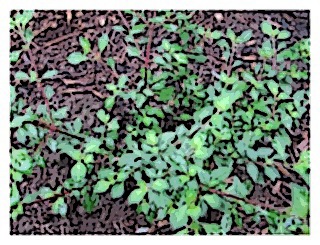
Habit—Gynodioecious. Erect shrub 2 to 4 m tall; branchlets ascending, vigorous, 30 to 90 cm long, 2 to 7 mm thick, quadrangular in transection, canescent to tomentose; older branches 8 to 45 mm thick.
Leaves—Lower leaves opposite to three at a node, upper ones opposite, chartaceous, lanceolate to broadly ovate, 35 to 125 mm long, 12 to 45 mm wide, serrulate, strigose pubescent on the upper surface, short pubescent on the lower surface; base acute to cuneate; apex acute; petiole pubescent, 7 to 22 mm long.

Flowers—Perfect flowers, pedicels drooping to spreading, pubescent, 18 to 25 mm long, hypanthium cylindric, 6.5 to 9.2 mm long, 3.4 to 3.9 mm wide at rim, 3.1 to 3.5 mm wide at base, short vinous pubescent outside and inside, sepals broadly lanceolate, 3.8 to 4.6 mm long, 1.7 to 2.1 mm wide at base, spreading to suberect, the apex acuminate, the tips connivent in bud, hypanthium and sepals red, petals red, orbicular to oblate, 3.8 to 4.2 mm long, 4.1 to 4.6 mm wide, pubescent, spreading to erect, the apex three- lobed, nectary a swollen disc with four membranous wings extending along the vascular bundles leading to the episepalous stamens, 1.8 to 2.1 mm high, episepalous stamens exserted 1.4 to 1.7 mm above the rim of the hypanthium, filaments unequal, the episepalous ones 0.6 to 0.9 mm long, the epipetalous ones 1.4 to 1.7 mm long, anthers 1.8 to 2.1 mm long, 0.5 to 0.8 mm thick, style 12.5 to 15.2 mm long, the stigma exserted 3.5 to 5.5 mm above the rim of the hypanthium, its lobes deltoid, suberect, 1 to 1.3 mm long. Pistillate flowers, similar to the perfect flowers in all except the following characteristics: pedicels 9 to 14 mm long, hypanthium 4 to 4.6 mm long, 1.9 to 2.2 mm wide at rim, 1.7 to 2 mm wide at base, sepals 2.2 to 2.6 mm long, 0.9 to 1.3 mm wide at base, petals 1 to 1.4 mm long, 0.6 to 0.8 mm wide, nectary 1.1 to 1.3 mm high, style stout, 6.8 to 7.5 mm long, the stigma exserted 2.5 to 3.2 mm above the rim of the hypanthium, its lobes 1 to 1.3 mm long.
lobed, nectary a swollen disc with four membranous wings extending along the vascular bundles leading to the episepalous stamens, 1.8 to 2.1 mm high, episepalous stamens exserted 1.4 to 1.7 mm above the rim of the hypanthium, filaments unequal, the episepalous ones 0.6 to 0.9 mm long, the epipetalous ones 1.4 to 1.7 mm long, anthers 1.8 to 2.1 mm long, 0.5 to 0.8 mm thick, style 12.5 to 15.2 mm long, the stigma exserted 3.5 to 5.5 mm above the rim of the hypanthium, its lobes deltoid, suberect, 1 to 1.3 mm long. Pistillate flowers, similar to the perfect flowers in all except the following characteristics: pedicels 9 to 14 mm long, hypanthium 4 to 4.6 mm long, 1.9 to 2.2 mm wide at rim, 1.7 to 2 mm wide at base, sepals 2.2 to 2.6 mm long, 0.9 to 1.3 mm wide at base, petals 1 to 1.4 mm long, 0.6 to 0.8 mm wide, nectary 1.1 to 1.3 mm high, style stout, 6.8 to 7.5 mm long, the stigma exserted 2.5 to 3.2 mm above the rim of the hypanthium, its lobes 1 to 1.3 mm long.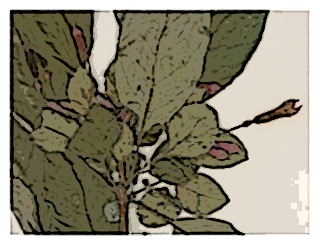
Seeds—Seeds, 14 to 18, 2.1 to 2.5 mm long, 1.1 to 1.3 mm thick, oblanceolate in outline, hilum subbasal.
Chromosomes—Gametic chromosome number n = 11.
Authors—Breedlove 1969.
Original publication—Univ. Calif. Publ. Bot. 53: 57 1969.
Herbarium Specimens—California Academy.
F. thymifolia Kunth (2 subspecies)
Mexico & Guatamala. A common shrub in the understory of Pinus, Quercus, and Abies forests from the mountains of Sinaloa and Durango, Mexico, southward to Chiapas and northern Guatemala, found growing at elevations from 1,800–3,200 meters.
Habit: Gynodioecious. Erect shrub 0.5 to 3 m tall; branchlets ascending, vigorous, 25 to 60 cm long, 1 to 3 mm thick, irregular in transection, subglabrous to canescent; older branches 15 to 35 mm thick.
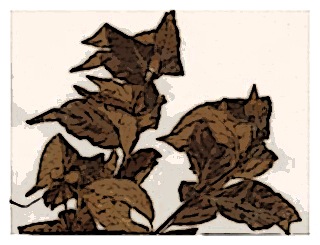 Leaves—Opposite to subopposite, chartaceous, elliptic to ovate, 8 to 65 mm long, 6 to 32 mm wide, entire or occasionally serrulate, pubescent on both surfaces; base obtuse to attenuate; apex obtuse to acute; petiole puberulent, 4 to 24 mm long.
Leaves—Opposite to subopposite, chartaceous, elliptic to ovate, 8 to 65 mm long, 6 to 32 mm wide, entire or occasionally serrulate, pubescent on both surfaces; base obtuse to attenuate; apex obtuse to acute; petiole puberulent, 4 to 24 mm long.
Flowers: Perfect flowers. pedicels drooping, puberulent, 4 to 26 mm long, hypanthium obconic, 2.6 to 6.5 mm long, 2.5 to 3.8 mm wide at rim, 0.5 to 1 mm wide at base, pubescent outside, short oppressed strigose pubescent inside, sepals lanceolate, 2.4 to 4.5 mm long, 1.3 to 2.2 mm wide at base, reflexed, the apex acuminate to caudate, the tips separate in bud, hypanthium and sepals greenish-white to pink, petals white to pink fading to deep purple after fertilization, broadly elliptic to rotund, 2 to 4 mm long, 1.5 to 3.2 mm wide, pubescent, spreading, the apex rounded, nectary of 8 discrete swellings, each with a membranous wing extending along the vascular bundle to the stamen, 0.6 to 0.8 mm high, episepalous stamens exserted 0.5 to 1 mm above the rim of the hypanthium, filaments unequal, the episepalous ones 0.9 to 1.1 mm long, the epipetalous ones 0.4 to 0.6 mm long, anthers 1 to 1.3 mm long, 0.5 to 0.7 mm thick, style 6 to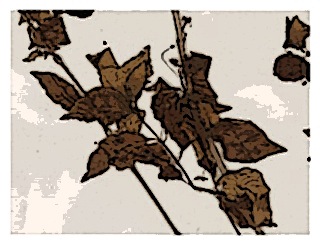 11.2 mm long, the stigma exserted 2.8 to 4.5 mm above the rim of the hypanthium, its lobes lanceolate, spreading, 0.9 to 1.5 mm long. Pistillate flowers, similar to the perfect ones in all except the following characteristics: pedicels 4 to 10 mm long, hypanthium 1.2 to 2.2 mm long, 1.1 to 1.7 mm wide at rim, 0.3 to 0.8 mm wide at base, sepals 1.8 to 2.7 mm long, 0.8 to 1.3 mm wide at base, petals 1.1 to 2.8 mm long, 0.5 to 1.3 mm wide, nectary 0.3 to 0.5 mm high, style stout, 2.9 to 4.5 mm long, the stigma exserted 1.5 to 2.4 mm above the rim of the hypanthium, its lobes 1.2 to 1.6 mm long.
11.2 mm long, the stigma exserted 2.8 to 4.5 mm above the rim of the hypanthium, its lobes lanceolate, spreading, 0.9 to 1.5 mm long. Pistillate flowers, similar to the perfect ones in all except the following characteristics: pedicels 4 to 10 mm long, hypanthium 1.2 to 2.2 mm long, 1.1 to 1.7 mm wide at rim, 0.3 to 0.8 mm wide at base, sepals 1.8 to 2.7 mm long, 0.8 to 1.3 mm wide at base, petals 1.1 to 2.8 mm long, 0.5 to 1.3 mm wide, nectary 0.3 to 0.5 mm high, style stout, 2.9 to 4.5 mm long, the stigma exserted 1.5 to 2.4 mm above the rim of the hypanthium, its lobes 1.2 to 1.6 mm long.
Seeds—Seeds, 12 to 18, 1.9 to 2.3 mm long, 0.9 to 1.1 mm thick, oblanceolate to elliptic in outline, hilum subbasal.
Authors—Humboldt, Bonpland & Kunth 1823.
Original publication—Nov. Gen. Sp. 6: 104 1823.
Synonyms—None.
Herbarium Specimens—Field Museum.
F. thymifolia subsp. minimiflora (Hemsl.) Breedlove.
Mexico & Guatemala. Occasional in forests of pine, oak and arbutus in the central highlands and the Sierra Madre of Chiapas State in Mexico, and in the Sierra de los Cuchumatanes and the high volcanos near Antiqua in Guatemala at elevations from 2,100 to 2,500 meters.
Habit—Gynodioecious. Erect shrub 2 to 4 m tall; branchlets ascending, vigorous, 30 to 90 cm long, 2 to 7 mm thick, quadrangular in transection, canescent to tomentose; older branches 8- to 5 mm thick.
Leaves—Lower leaves opposite to three at a node, upper ones opposite, chartaceous, lanceolate to broadly ovate, 35 to 125 mm long, 12 to 45 mm wide, serrulate, strigose pubescent on the upper surface, short pubescent on the lower surface; base acute to cuneate; apex acute; petiole pubescent, 7 to 22 mm long.
Flowers—Perfect flowers, pedicels drooping to spreading, pubescent, 18 to 25 mm long, hypanthium cylindric, 6.5 to 9.2 mm long, 3.4 to 3.9 mm wide at rim, 3.1 to 3.5 mm wide at base, short vinous pubescent outside and inside, sepals broadly lanceolate, 3.8 to 4.6 mm long, 1.7 to 2.1 mm wide at base, spreading to suberect, the apex acuminate, the tips connivent in bud, hypanthium and sepals red, petals red, orbicular to oblate, 3.8 to 4.2 mm long, 4.1 to 4.6 mm wide, pubescent, spreading to erect, the apex three-lobed, nectary a swollen disc with four membranous wings extending along the vascular bundles leading to the episepalous stamens, 1.8 to 2.1 mm high, episepalous stamens exserted 1.4 to 1.7 mm above the rim of the hypanthium, filaments unequal, the episepalous ones 0.6 to 0.9 mm long, the epipetalous ones 1.4 to 1.7 mm long, anthers 1.8 to 2.1 mm long, 0.5 to 0.8 mm thick, style 12.5-15.2 mm long, the stigma exserted 3.5-5.5 mm above the rim of the hypanthium, its lobes deltoid, suberect, 1 to 1.3 mm long. Pistillate flowers, similar to the perfect flowers in all except the following characteristics: pedicels 9 to 14 mm long, hypanthium 4 to 4.6 mm long, 1.9 to 2.2 mm wide at rim, 1.7 to 2 mm wide at base, sepals 2.2 to 2.6 mm long, 0.9 to 1.3 mm wide at base, petals 1 to 1.4 mm long, 0.6 to 0.8 mm wide, nectary 1.1 to 1.3 mm high, style stout, 6.8 to 7.5 mm long, the stigma exserted 2.5 to 3.2 mm above the rim of the hypanthium, its lobes 1 to 1.3 mm long.
Seeds—14 to 18, 2.1 to 2.5 mm long, 1.1 to 1.3 mm thick, oblanceolate in outline, hilum subbasal.
Chromosomes: Gametic chromosome number n = 11.
Authors—Hemsley 1878. Breedlove 1969 (subspecies).
Original publication—Univ. Calif. Publ. Bot. 53: 50 1969.
Synonyms—F. minimiflora, Hemsley 1878; F. tacanensis, Lundell 1940; F. skutchiana, Munz 1943.
Herbarium Specimens—Missouri; Smithsonian.
F. thymifolia subsp. thymifolia Kunth.
Mexico. Common in the understory of pine, oak and fir forests from the Sierra Madre Occidental of Sinaloa and Durango southward to Jalisco and east across the Trans-Mexican Volcanic Belt to Vera Cruz, then north to the Sierra de Pachuca of Hidalgo and south to the Sierra Juárez of Oaxaca at elevations from 2,000 to 3,200 meters.
Habit—Shrub 0.5 to 2.2 m tall; branchlets 25 to 40 cm long; older branches 15 to 25 mm thick.
Leaves—Broadly elliptic to ovate, 8 to 30 mm long, 6– to 5 mm wide; base obtuse to attenuate; apex obtuse to acute; petiole 4 to 17 mm long.
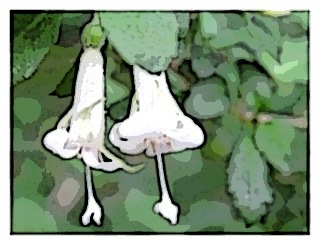 Flowers—Perfect flowers, pedicels 4 to 12 mm long, hypanthium 3.5 to 6.5 mm long, 2.5 to 3.8 mm wide at rim, 0.5 to 1 mm wide at base, sepals 2.5 to 4.5 mm long, 1.5 to 2.2 mm wide at base, petals 2 to 4 mm long, 1.5 to 3.2 mm wide, style 7.5 to 11.2 mm long, the stigma exserted 3 to 4.5 mm above the rim of the hypanthium, its lobes 0.9 to 1.1 mm long. Pistillate flowers. pedicels 4 to 8 mm long, hypanthium 1.2 to 2.2 mm long, 1.1 to 1.7 mm wide at rim, 0.3 to 0.6 mm wide at base, sepals 1.6 to 2.7 mm long, 0.8 to 1.3 mm wide at base, petals 1.1 to 1.8 mm long, 0.5 to 1.2 mm wide, style 2.9 to 4.5 mm long, the stigma exserted 1.5 to 2.2 mm above the rim of the hypanthium, its lobes 1.2 to 1.4 mm long.
Flowers—Perfect flowers, pedicels 4 to 12 mm long, hypanthium 3.5 to 6.5 mm long, 2.5 to 3.8 mm wide at rim, 0.5 to 1 mm wide at base, sepals 2.5 to 4.5 mm long, 1.5 to 2.2 mm wide at base, petals 2 to 4 mm long, 1.5 to 3.2 mm wide, style 7.5 to 11.2 mm long, the stigma exserted 3 to 4.5 mm above the rim of the hypanthium, its lobes 0.9 to 1.1 mm long. Pistillate flowers. pedicels 4 to 8 mm long, hypanthium 1.2 to 2.2 mm long, 1.1 to 1.7 mm wide at rim, 0.3 to 0.6 mm wide at base, sepals 1.6 to 2.7 mm long, 0.8 to 1.3 mm wide at base, petals 1.1 to 1.8 mm long, 0.5 to 1.2 mm wide, style 2.9 to 4.5 mm long, the stigma exserted 1.5 to 2.2 mm above the rim of the hypanthium, its lobes 1.2 to 1.4 mm long.
Chromosomes—Gametic chromosome number n = 11.
Authors—Breedlove 1969.
Original publication—Nov. Gen. Sp. 6: 104 1823; Univ. Calif. Publ. Bot. 53: 50 1969.
Synonyms—Brebissonia thymifolia, (Kunth) Spach 1835; Lyciopsis thymifolia, (Kunth) Spach 1835; F. pringlei, Robinson & Seaton 1893; F. colimae, Munz 1943.
Herbarium Specimens—Arizona State 1, Arizona State 2, Arizona State 3, Arizona State 4; California Academy 1, California Academy 2; Kew; Missouri; Smithsonian 1, Smithsonian 2.

F. x bacillaris Lindl.
Mexico. This is a natural hybrid between Fuchsia microphylla subsp. microphylla x Fuchsia thymifolia subsp. thymifolia.
Authors—Lindley 1832. Breedlove 1969.
Original publication—Edwards's Bot. Reg. 18: t. 1480 1832.
Synonyms—Brebissonia bacillaris, Spach 1835; F. cinnabarina, McClintock 1950.
Herbarium Specimens—Kew 1, Kew 2.
Synonyms—; Encliandra parviflora, Zuccarini 1837; F. parviflora, Hemsley 1828.
Herbarium Specimens—Field Museum.
F. encliandra subsp. encliandra (Zucc.) Steud.

Habit—Shrub 0.5 to 2 m tall; branchlets 35 to 55 cm long, 0.5 to 3 mm thick; older branches 3 to 25 mm thick.

Leaves—Elliptic to narrowly ovate, 9 to 27 mm long, 4 to 17 mm wide, glabrous to puberulent on both surfaces; base cuneate to attenuate; apex acute to short acuminate; petiole 1 to 9 mm long.
Flowers—Staminate flowers, pedicels 9 to 20 mm long, hypanthium 7 to 12 mm long, 2 to 3.3 mm wide at rim, 1.8 to 3 mm wide at base, glabrous to pubescent outside, sepals 2.7 to 4.5 mm long, 1.6 to 2.6 mm wide at base, petals 2.2 to 4 mm long, 1.8 to 2.8 mm wide, nectary 1.6 to 1.9 mm high. Pistillate flowers, pedicels 8 to 10 mm long, hypanthium 4.5 to 7.3 mm long, 1.5 to 2.5 mm wide at rim, 1.4 to 2.4 mm wide at base, sepals 2.4 to 3.6 mm long, 0.8 to 1.6 mm wide at base, petals 1.2 to 2 mm long, 0.7 to 1.2 mm wide, nectary 0.4 to 0.6 mm high, style 6.5 to 12.5 mm long, the stigma exserted 2 to 3.8 mm above the rim of the hypanthium, its lobes 0.7 to 1 mm long.

Seeds—Seeds, 6 to 18, 2.1 to 3.4 mm long, 1.1 to 2.7 mm thick.
Chromosomes: Gametic chromosome number n = 11.
Author—Steudel 1840.
Original publication—Nomencl. Bot. ed. 2, 1: 649 1840.
Synonyms—F. acynifolia, Scheidweiler 1847.
Herbarium Specimens—None known on-line.
F. encliandra subsp. microphylloides P.E.Berry & Breedlove
Mexico. Abundant in wet pine-oak forests and in cloud forests along the crest of the Sierra Madre of Guerrero, Michoacán, and Oaxaca, in Mexico. It is mainly found above 2,000 meters in elevation, usually between 2,200 and 2,500 meters, but can occasionally range up to 3,000 meters.

Habit—Shrub 1 to 2 m tall, dioecious; branchlets 4 to 18 cm long, emerging at a + 90' angle from the main stem, subglabrous to finely appressed-pubescent with tan hairs 0.2 to 0.4 mrn long.
Leaves—Opposite, firmly membranous, the blade lance-elliptic, 15 to 40 (to 50) mm long, 7 to 15 mm wide, glabrous on both sides or sometimes with fine appressed hairs along veins or margins on lower surface, secondary veins 4 to 6 on either side of the midvein or sometimes inconspicuous, apex acute, base attenuate. margin subentire to serrulate. sometimes + revolute; petiole 4 to 10 mm long; stipules narrowly lanceolate, dark brown. ca. 0.3 mm wide, 0.5 to 0.7 mm long, deciduous.

Flowers—Staminate flowers, pedicels 5 to 22 mm long, floral tube cylindrical, glabrous, magenta, 9 to 11 mm long, 2 to 4 mm wide at the rim, 1.5 to 2 mm wide at the base, sepals triangular, 3 to 4 mm long, 2 to 2.5 mm wide at the base, spreading, the apex shortly acuminate, petals magenta, subrotund, 2 to 3 mm long, 2 to 3 mm wide, slightly three-lobed at the apex, nectary 0.9 to 11 mm high, entire, style 6 to 10 mm long, included within the floral tube, the stigma inconspicuous, aborted, antesepalous stamens exserted above the rim of the tube, antepetalous ones included inside the floral tube, filaments 1.0-1.5 mm long, anthers oblong 1.6 to 2.0 mm long, 0.7 to 1.0 mm thick. Pistilate flowers, pedicels 4 to 7 mm long, ovary spherical circa 2 mm in diameter, floral tube narrowly cylindric, 5 to 7 mm long, 2 to 2.5 mm wide at the rim, ca. 1mm wide at the base, sepals triangular, 2.5 mm long, 1.5 to 2 mm wide at the base, petals 1.3 to 2 mm long, 1 to 1.3 mm wide, sterile anthers oblong, 0.5 to 0.8 mm long, filaments 0.2 to 0.6 mm

Fruit—The berry is subglobose and 4 to 5.5 mm in diameter.
Seeds: The seeds are 12 to 18, 1.5 to 2.0 mm long, and 0.9 to 1.1 mm thick.
Chromosomes: Gametic chromosome number n = 11. [Not verified?]
Authors—P.E.Berry & Breedlove 1996.
Original publication—Novon 6(2): 139, f. 3. 1996.
Synonyms—None.
Herbarium Specimens—Missouri.
F. encliandra ssp. tetradactyla (Lindl.) Breedlove
Mexico & Central America. Locally abundant in forests of pine, oak and arbutus in scattered localities from central Chiapas, Mexico, through Guatemala, El Salvador, Honduras, and northern Nicaragua at elevations from1,500 to 2,400 meters.

Habit—Shrub 0.8 to 2.5 m tall; branchlets 25 to 55 cm long, 2.5 to 5 mm thick; older branches 5 to 35 mm thick.
Leaves—Elliptic to broadly ovate, 22 to 110 mm long, 8 to 50 mm wide, strigulose on both surfaces; base obtuse to attenuate; apex acute to acuminate; petiole 10 to 35 mm long.
Flowers—Staminate flowers, pedicels 8 to 20 mm long, hypanthium. 6.3 to 7.8 mm long, 2.8 to 3.1 mm wide at rim, 2.4 to 2.8 mm wide at base, sepals 2.8 to 4.6 mm long, 1.8 to 2.4 mm wide at base, petals 2.5 to 3.7 mm long, 1.8 to 2.4 mm wide , nectary 1.4 to 1.7 mm high. Pistillate flowers, pedicels 8 to 12 mm long, hypanthium 3.8 to 6 mm long, 1.2 to 1.8 mm wide at rim, 1.1 to 1.3 mm wide at base, sepals 2.1 to 2.7 mm long, 0.7 to 1.4 mm wide at base, petals 1.4 to 1.8 mm long, 0.9 to 1.1 mm wide, nectary 0.9 to1.1 mm high, style 6 to 9.5 mm long, the stigma exserted 3.5 to 5 mm above the rim of the hypanthium, its lobes 0.7 to 1.2 mm long,
Seeds—Seeds number 6 to 8, 2.5 to 3.4 mm long, 2 to 2.7 mm thick.

Chromosomes: Gametic chromosome number n 11.
Authors—(Lundell) Breedlove 1969.
Original publication—Univ. Calif. Publ. Bot. 53: 53 1969.
Synonyms—Fuchsia tetradactyla, Lindley 1846; F. seleriana, Loesener 1913; F. striolata, Lundell 1940.
Herbaria—California Academy 1, California Academy 2; Field Museum; Kew; Missouri; Smithsonian 1, Smithsonian 2; Texas.
F. microphylla Kunth (6 subspecies)
Authors—Humboldt, Bonpland & Kunth 1823
Original publication—Nov. Gen. Sp. 6: 103 1823.
Herbarium Specimens—Arizona State 1, Arizona State 2; Field Museum; Texas 1, Texas 2, Texas 3, Texas 4, Texas 5.
F. microphylla subsp. aprica (Lundell) Breedlove
Mexico. Common in dense forests of fir and oak and evergreen cloud forests from the central highlands and the Sierra Madre del Sur of Chiapas State south through Guatemala, El Salvador, and scattered locations in Honduras at elevations from 1,500 to 3,500 meters.
Habit—Shrub 1 to 3 m tall; branchlets 5 to 18 cm long, subglabrous to canescent with white hairs; older branches 5 to 23 mm thick.
Leaves—Chartaceous to coriaceous, narrowly lanceolate to broadly elliptic, 1.2 to 3.8 mm long, 0.6 to 2.8 mm wide, glabrous to pubescent on the margins and veins; base acute to attenuate; apex acute to naucronate; petiole 1.3 to 15 mm long.
Flowers—Perfect flowers, pedicels 6 to 15 mm long, hypanthium subcylindric to cylindric, 6.5 to 12.8 mm long, 2.5 to 4.2 mm wide at rim, 2.2 to 3.2 mm wide at base, glabrous to heavily pubescent, sepals 3.5 to 6.2 mm long, 1.8 to 3 mm wide at base, spreading to suberect, the apex acute to long acuminate, hypanthium and sepals red to purplish-red, petals red to pale purplish-red, 2.8 to 4.8 mm long, 2 to 4.5 mm wide, the apex rounded to emarginate, slightly pubescent on the outer surface, nectary entire, 0.8 to 1.2 mm high, episepalous stamens exserted 0.6 to 2.4 mm above the rim of the hypanthium, filaments equal 1.3 to 1.6 mm long, anthers 1.4 to 1.7 mm long, 0.6 to 0.8 mm thick, style 8.8-17.7 mm long, the stigma exserted 2.5 to 7.9 mm above the rim of the hypanthium, its lobes suberect, 0.4 to 0.7 mm long. Pistillate flowers, pedicels 4 to 12 mm long, hypanthium 3.5 to 5.8 mm long, 1.4 to 1.8 mm wide at rim, 1.0 to 1.5 mm wide at base, sepals 2.8 to 3.9 mm long, 1.2 to 1.6 mm wide at base, petals 1 to 1.7 mm long, 0.5 to 1.2 mm wide, nectary 0.5 to 0.7 mm high, style 5.6 to 7.8 mm long, the stigma exserted 1.6 to 2.7 mm above the rim of the hypanthium, its lobes 0.7 to 0.9 mm long.
Seeds—Seeds 14 to 24, 1.9 to 2.4 mm long, 0.9 to 1.2 mm thick.
Chromosomes—Gametic chromosome number n =11, 22.
Authors—(Lundell) Breedlove 1969.
Original publication—Univ. Calif. Publ. Bot. 53: 45 1969.
Synonyms—F. aprica, Lundell 1940; F. microphylla var. aprica, (Lundell) Munz 1943.
Herbarium Specimens—MIssouri; New York; Smithsonian.
F. microphylla subsp. chiapensis (Brandegee) P.E.Berry & Breedlove
Mexico. In the mountains of southwestern Chiapas State (Sierra de Soconusco) in Mexico and in scattered localities along the Pacific slope of Guatemala and El Salvador in montane rainforest, evergreen cloud forest, and wet pine-oak forest at elevations from 1,800 and 2,400 meters.
Habit—Shrub 1 to 2 m tall, gynodioecious; branchlets 5 to 15 cm long, lightly to densely strigose with tan to white hairs.
Leaves—Opposite, membranous, the blade elliptic-ovate, 15 to 40(-50) mm long, 8 to 23 (to 30) mm wide, with scattered hairs on the lower surface along the veins, secondary veins 4-6 on mm wide at the base.
Flowers—Sepals 2.5 to 4 mm long, 1.5 to 2.5 mm wide at the base, spreading, the apex subacuminate, petals red, 2 to 3 mm long, 2 to 4 mm wide, three-lobed at the apex, nectary 0.7 to 1.2 mm high, entire: style 8 to 12 mm long, the stigma capitate, exserted 3 to 6 mm beyond the rim of the tube: antesepalous stamens exserted above the rim of the tube, antepetalous ones included inside the floral tube, filaments 0.5 to 1.5 mm long: anthers 1.4 to 2.0 mm long, 0.7 to 1.0 mm thick, Female flowers, pedicels 6 to 20 mm long, floral tube cylindric-obconic, 4 to 6 mm long, 2 to 2.5 mm wide at the rim, circa 1mm wide at the base, sepals narrowly triangular. 3 to 5 mm long. 1.5 to 2 mm wide at the base, petals 0.7 to 2 mm long, 0.7 to 1.7 mm wide: sterile anthers oblong, 0.5 to 1 mm long, filaments 0.3 to 0.8 mm long, nectary 0.5 to 0.8 mm high, style 7 to 8 mm long, the stigma exserted 1.5 to 2.5 mm beyond the rim of the tube its lobes circa 1 mm long.
Fruit—Fruit subglobose, 5 to 7 mm diameter.
Seeds—Seeds 12 to 20, 1.9 to 2.4 mm long, 1 to 1.3 mm thick.
Chromosomes—Gametic chromosome number n = 11. [Not verified?]
Authors—(Brandegee) P.E.Berry & Breedlove 1996.
Original publication—Novon 6: 137 1996.
Synonyms—F. chiapensis, Brandegee 1914; F. heterotricha, Lundell 1940.
Herbarium Specimens—Smithsonian 1, Smithsonian 2.
F. microphylla subsp. hemsleyana (Woodson & Seibert) Breedlove
Costa Rica & Panama. Common in the understory of evergreen cloud forests on the high volcanos of Costa Rica and northern Panama at elevations from 1,500 to 3,100 meters.

Leaves—Subcoriaceous, lanceolate to elliptic, 0.2-30 mm long, 6-12 mm wide, entire to serrate, the margins and main veins ciliate; base attenuate; apex acute to acuminate ; petiole 4-15 mm long.
Flowers—Perfect flowers, pedicels 5 to 11 mm long, hypanthium subcylindric, 7 to 11 mm long, 2.4 to 3.7 mm wide at rim, 1.4 to 2.5 mm wide at base, pubescent, sepals 3.5 to 5.2 mm long, 1.4 to 2.6 wide at base, reflexed to spreading, the apex acuminate to caudate, hypanthium and sepals red, petals red, 1.6 to 2.4 mm long, 1.4 to 1.7

Fruit—Fruit with 16 to 24 seeds, seeds 2 to 2.1 mm long, 0.9 to 1.1 mm thick.

Chromosomes—Gametic chromosome number, n = 11.
Authors—(Woodson & Seibert) Breedlove 1969.
Original publication—Univ. Calif. Publ. Bot. 53: 47 1969.
Synonyms—F. hemsleyana, Woodson & Seibert 1937; F. pulchella, Woodson & Seibert 1937.
Herbarium Specimens—Kew; California Academy; MIssouri 1. Missouri 2; New York,
F. microphylla subsp. hidalgensis (Munz) Breedlove
Central Mexico. Scattered to rare in mixed evergreen forests of pine and oak in southeastern Hidalgo and northern Puebla states from 1,600 to 2,200 meters in elevation.
Habit—Shrub 0.5 to 2 m tall; branchlets 5 to 30 cm long, canescent with brown hairs; older branches 5 to 15 mm thick.
Leaves—Subcoriaceous, lanceolate to narrowly oblanceolate, 6 to 25 mm long, 4 to 10 mm wide, serrate from the apex for about three-quarters of the margin, 4 to 12 teeth on each side, ciliate on the margins and veins; base attenuate; apex acute to mucronate; petiole 0.5- to mm long.
Flowers—Perfect flowers, pedicels 3 to 8 mm long, hypanthium narrowly obconic, 4.2 to 5.6 mm long, 1.73 mm wide at rim, 0.5 to 1.2 mm wide at base, subglabrous to puberulent, sepals 3.8 to 5.2 mm long, 1.2 to 1.8 to 2 mm wide, rotund, apex rounded, glabrous to puberulent, nectary deeply four-lobed, 0.6 to 0.8 mm high, episepalous stamens exserted 0.8 to 1.1 mm above the rim of the hypanthium, filaments equal, 0.6 to 0.9 mm long, anthers 1 to 1.4 mm long, 0.4 to 0.6 mm thick, style 9.2 to 10.9 mm long, the stigma exserted 3.5 to 5.6 mm above the rim of the hypanthium, its lobes spreading, 0.9 to 1.1 mm long. Pistillate flowers, pedicels 1 to 3 mm long, hypanthium 2.2 to 3.6 mm long, 1.3 to 1.8 mm wide at rim, 0.3 to 0.8 mm wide at base, sepals 2 to 3.2 mm long, 0.9 to 1.2 mm wide at base, petals 1.2 to 1.5 mm long, 0.8 to 1.2 mm wide, nectary 0.3 to 0.5 mm high, style 4.6 to 5.8 mm long, the stigma exserted 1 to 1.8 mm above the rim of the hypanthium, its lobes 0.9 to 1.2 mm long.
Seeds—25 to 36 seeds per berry, 1 to 1.2 mm long, 0.5 to 0.7 mm thick.
Chromosomes: Gametic chromosome number n = 11.
Authors—(Munz) Breedlove 1969.
Original publication—Univ. Calif. Publ. Bot. 53: 43 1969.
Synonyms—F. minutiflora, Hemsley; var. hidalgensis, Munz 1943.
Herbarium Specimens—Arizona State 1, Arizona State 2, Arizona State 3; Edinburgh; Kew; New York; Smithsonian.
F. microphylla subsp. microphylla (Kunth) Breedlove
Mexico. 2100-3200 m. In forests of pine, oak, and fir on the higher slopes of the Trans-Mexican Volcanic Belt from Jalisco to Vera Cruz, also in fir and evergreen cloud forests on isolated high mountains of the Sierra Madre Oriental of Hidalgo, the Sierra Madre of Guerrero and the Sierra de Zempoaltepetl of Oaxaca at elevations from 2,100 to 3,200 meters.
Habit—Shrub 0.5 to 3 m tall; branchlets 5 to 15 cm long, subglabrous or canescent with white or brown hairs; older branches 5 to 20 mm thick.
Leaves—Coriaceous, narrowly elliptic to elliptic, 8 to 30 (to 40) mm long, 4 to 12 mm wide, serrate from the apex to the middle, entire from the middle to the base, glabrous to ciliate on the margins; base attenuate; apex acute to mucronate; petiole 0.5 to 7 mm long.

Flowers—Perfect flowers, pedicels 6 to 12 mm long, hypanthium subcylindric to cylindric, 7 to 10.5 mm long, 2.9 to 4.2 mm wide at rim, 1.8 to 2.6 mm wide at base, glabrous or with a few scattered hairs outside, sepals 3.5 to 6 long, 2.2 to 2.8 mm wide at base, spreading, the apex mucronate to long acuminate, hypanthium and sepals purplish-red, petals pale purplish-red, 3.5 to 5.8 mm long, 2.5 to 4.4 mm wide, the apex emarginate, slightly pubescent on the outer surface, nectary entire, 1.1 to 1.4 mm high, episepalous stamens exserted 1.4 to 2.4 mm above the rim of the hypanthium, filaments unequal, the episepalous ones 0.9 to 1.3 mm long, the epipetalous ones 1.5 to 1.9 mm long, anthers 1.2 to 1.7 mm long, 0.5 to 0.8 mm thick, style 11.4 to 17.2 mm long, the stigma exserted 4.2 to 7.5 mm above the rim of the hypanthium, its lobes spreading, 0.4 to 0.7 mm long. Pistillate flowers, pedicels 4 to 10 mm long, hypanthium 3 to 6.5 mm long, 1.4 to 2.6 mm wide at rim, 1.2 to 2 mm wide at base, sepals 2.3 to 4 mm long, 1 to 2.1 mm wide at base, petals 1.6 to 3 mm long, 0.8 to 1.8 mm wide, nectary 0.7 to 0.9 mm high, style 5.4 to 8.6 mm long, the stigma exserted 1.5 to 3 mm above the rim of the hypanthium, its lobes 0.8 to 1.3 mm long.
Seeds—Seeds 12 to 18, 1.8 to 2.6 mm long, 0.9 to 1.2 mm thick.

Chromosomes—Gametic chromosome number n = 11.
Authors—Breedlove 1969.
Original publication—Nov. Gen. Sp. 6: 103 1823.
Synonyms—Hemsley 1878; F. minutiflora var. typica, Munz 1943; F. mixta, Hemsley 1878; F. notarsii, Lehmann 1852; F. uniflora, Sesse & Mociño 1888; Myrinia microphylla, (H. B. K.) Lilja 1840.
Herbarium Specimens—Kew 1, Kew 2; California Academy.
F. microphylla subsp. quercetorum (Kunth) Breedlove
Mexico & Guatemala. In open forests with pintas, oak and sweet gum from the central highlands of Chiapas State in Mexico south to the Sierra las Minas in Guatemala at elevations from 1,500 to 2,200 meters.
Habit—Shrub 0.5 to 2.5 m tall; branchlets 5 to 20 cm long, glabrous to canescent, with white hairs; older branches 5 to 30 mm thick.
Leaves—Subcoriaceous to coriaceous, elliptic to broadly lanceolate, 6 to 30 mm long, 3 to 14 mm wide, entire, re-volute, glabrous to pubescent on. the margins and veins; base acute to attenuate; apex acute; petiole 3 to 8 mm long.
Flowers—Perfect flowers, pedicels 8 to 16 mm long, hypanthium cylindric, 6 to 8.5 mm long, 1.9 to 2.3 mm wide at rim, 1.7 to 2.1 mm wide at base, subglabrous to puberulent, sepals 1.9 to 2.8 mm long, 1.6 to 2.3 mm)(vide at base, spreading to suberect, the apex acute to acuminate, hypanthium and sepals red, petals red, 1.5 to 2.6 mm long, 1.2 to 2.1 mm wide, the apex rounded, puberulent on the outer surface, nectary entire, 1 to 1.5 mm high, episepalous stamens exserted 0.7 to 1 mm above the rim of the hypanthium, filaments equal, 0.8 to 1 mm long, anthers 1 to 1.3 mm long, 0.5 to 0.6 mm thick, style 8.4 to 12.8 mm long, the stigma exserted 2.8 to 5 mm above the rim of the hypanthium, its lobes spreading, 0.4 to 0.7 mm long. Pistillate flowers pedicels 4 to 8 mm long, hypanthium 2.6 to 4 mm long, 1.4 to 1.8 mm wide at rim, 1.3 to 1.6 mm wide at base, sepals 1.2 to 1.9 mm long, 0.9 to 1.2 mm wide at base, petals 0.8 to 1 mm long, 0.6 to 0.8 mm wide, nectary 0.7 to 0.9 mm high, style 4.8 to 6.4 mm long, the stigma exserted 1.8 to 2.4 mm above the rim of the hypanthium, its lobes 0.8 to 1.2 mm long.
Seeds—Seeds 12 to 18, 1.7 to 2.4 mm long, 0.9 to 1.1 mm thick.
Chromosomes—Gametic chromosome number n =11.
Authors—Breedlove 1969.
Original publication—
Synonyms—None.
Herbarium Specimens—California Academy.
F. obconica Breedlove
Mexico. Abundant in forests of pine and oak in scattered localities on the lower mountains of the Trans-Mexican

Habit—Dioecious. Erect shrub, 1 to 3 m tall; branchlets ascending, vigorous, 20 to 60 cm long, 0.5 to 3 mm thick, quadrangular in transection, sparsely to densely canescent; older branches 15 to 35 mm thick.
Leaves—Opposite to subopposite, chartaecous to subcoriaceous, lanceolate or oblanceolate to broadly elliptic, 11 to 63 mm long, 6 to 24 mm wide, serrate, glabrous to sparsely puberulent on the upper surface, pubescent on the margin and veins below; base obtuse to cuneate; apex acute; petiole pubescent, 3 to 29 mm long.

Flowers—Staminate flowers, pedicels spreading to drooping, pubescent, 4 to 7 mm long, hypanthium obconic, 4.8 to 7.7 mm long, 1.8 to 2.6 mm wide at rim, 0.9 to 1.6 mm wide at base, pubescent outside, villous pubescent on the lower third inside, sepals lanceolate, 2.4 to 3.2 mm long, 1.2 to 1.8 mm wide at base, reflexed, the apex acuminate to cuspidate, the tips connivent in bud, hypanthium and sepals greenish-white to white, petals white, elliptic to rotund, 2.1 to 2.8 mm long, 1.9 to 2.5 mm wide, glabrous to sparsely puberulent, spreading, apex rounded, nectary a deeply four-lobed swollen disc, 0.5 to 0.8 mm high, episepalous stamens exserted 0.9 to 1.3 mm above the rim of the hypanthium, filaments equal, 0.7 to 1 mm long, anthers 1.2 to 1.5 mm long, 0.4 to 0.6 mm thick, style filiforma, 2.4 to 4.6 mm long, stigma usually undeveloped, ovary undeveloped. Pistillate flowers, similar to the staminate in all except the following: pedicels 3 to 5 mm long, hypanthium subcylindric to obconic, 1.8 to 3.8 mm long, 1 to 1.5 mm wide at rim, 0.8 to 1.2 mm wide at base, sepals 0.9 to 1.6 mm long, 0.6 to 0.8 mm wide at base, petals 0.6 to 1 mm long, 0.3 to 0.6 mm wide, nectary 0.4 to 0.6 mm high, style 3.5 to 6 mm long, the stigma exserted 1.6 to 3.3 mm above the rim of the hypanthium, its lobes broadly lanceolate, suberect, 0.9 to 1.3 mm long,

Seeds—Seeds 12 to 16, 2.1 to 2.6 mm long, 0.9 to 1.1 mm thick, oblanceolate to elliptic in outline, hilum subbasal.
Chromosomes: Gametic chromosome number n = 11.
Authors—Breedlove 1969.
Original publication—Univ. Calif. Publ. Bot. 53: 54 1969.
Synonyms—None.
Herbarium Specimens—Field Museum; Kew 1, Kew 2; California Academy 1, California Academy 2; Smithsonian.
F. parviflora Lindl.
Mexico. Scattered in canyons with forests of pine, oak and arbutus and in evergreen cloud forests from the Sierra Madre Occidental of southwestern Durango through the western part of the Trans-Mexican Volcanic Belt of Jalisco, Michoacán, and México to the Sierra Madre of Guerrero at elevations from 1,500 to 2,500 meters.

Habit—Dioecious. Erect shrub, 1.5 to 4 m tall; branchlets ascending, vigorous, 3 to 6.5 dm long, 0.5 to 6 mm thick, somewhat quadrangular in transection, subglabrous to loosely villous pubescent with white wavy hairs. Older branches are 15 to 55 mm thick.
Leaves—Opposite, chartaceous, oblanceolate to ovate, 30 to 75 mm long, strigose pubescent on both surfaces; base cuneate to attenuate; apex acute to apiculate; petiole pubescent, 8 to 45 mm long.


Chromosomes—Gametic chromosome number n = 11.
Authors—Lindley 1838.
Original publication—Bot. Reg. 13: t. 1048 1827.
Synonyms—F. cylindracea Lindl. 1838; F. michoacanensis, Sesse & Mociño 1888; F. biflora, Sesse & Mociño 1894; F. mexiae, Munz 1943.
Herbarium Specimens—Arizona State 1, Arizona State 2; Missouri; Smithsonian 1, Smithsonian 2.
F. ravenii Breedlove.
Mexico. Locally abundant in pine, oak and alder forests in the Sierra Madre near San Miguel Suchixtepec in Oaxaca State at about 2.600 meters in elevation.

Habit—Gynodioecious. Erect shrub 2 to 4 m tall; branchlets ascending, vigorous, 30 to 90 cm long, 2 to 7 mm thick, quadrangular in transection, canescent to tomentose; older branches 8 to 45 mm thick.
Leaves—Lower leaves opposite to three at a node, upper ones opposite, chartaceous, lanceolate to broadly ovate, 35 to 125 mm long, 12 to 45 mm wide, serrulate, strigose pubescent on the upper surface, short pubescent on the lower surface; base acute to cuneate; apex acute; petiole pubescent, 7 to 22 mm long.

Flowers—Perfect flowers, pedicels drooping to spreading, pubescent, 18 to 25 mm long, hypanthium cylindric, 6.5 to 9.2 mm long, 3.4 to 3.9 mm wide at rim, 3.1 to 3.5 mm wide at base, short vinous pubescent outside and inside, sepals broadly lanceolate, 3.8 to 4.6 mm long, 1.7 to 2.1 mm wide at base, spreading to suberect, the apex acuminate, the tips connivent in bud, hypanthium and sepals red, petals red, orbicular to oblate, 3.8 to 4.2 mm long, 4.1 to 4.6 mm wide, pubescent, spreading to erect, the apex three-


Seeds—Seeds, 14 to 18, 2.1 to 2.5 mm long, 1.1 to 1.3 mm thick, oblanceolate in outline, hilum subbasal.
Chromosomes—Gametic chromosome number n = 11.
Authors—Breedlove 1969.
Original publication—Univ. Calif. Publ. Bot. 53: 57 1969.
Herbarium Specimens—California Academy.
F. thymifolia Kunth (2 subspecies)
Mexico & Guatamala. A common shrub in the understory of Pinus, Quercus, and Abies forests from the mountains of Sinaloa and Durango, Mexico, southward to Chiapas and northern Guatemala, found growing at elevations from 1,800–3,200 meters.
Habit: Gynodioecious. Erect shrub 0.5 to 3 m tall; branchlets ascending, vigorous, 25 to 60 cm long, 1 to 3 mm thick, irregular in transection, subglabrous to canescent; older branches 15 to 35 mm thick.

Flowers: Perfect flowers. pedicels drooping, puberulent, 4 to 26 mm long, hypanthium obconic, 2.6 to 6.5 mm long, 2.5 to 3.8 mm wide at rim, 0.5 to 1 mm wide at base, pubescent outside, short oppressed strigose pubescent inside, sepals lanceolate, 2.4 to 4.5 mm long, 1.3 to 2.2 mm wide at base, reflexed, the apex acuminate to caudate, the tips separate in bud, hypanthium and sepals greenish-white to pink, petals white to pink fading to deep purple after fertilization, broadly elliptic to rotund, 2 to 4 mm long, 1.5 to 3.2 mm wide, pubescent, spreading, the apex rounded, nectary of 8 discrete swellings, each with a membranous wing extending along the vascular bundle to the stamen, 0.6 to 0.8 mm high, episepalous stamens exserted 0.5 to 1 mm above the rim of the hypanthium, filaments unequal, the episepalous ones 0.9 to 1.1 mm long, the epipetalous ones 0.4 to 0.6 mm long, anthers 1 to 1.3 mm long, 0.5 to 0.7 mm thick, style 6 to

Seeds—Seeds, 12 to 18, 1.9 to 2.3 mm long, 0.9 to 1.1 mm thick, oblanceolate to elliptic in outline, hilum subbasal.
Authors—Humboldt, Bonpland & Kunth 1823.
Original publication—Nov. Gen. Sp. 6: 104 1823.
Synonyms—None.
Herbarium Specimens—Field Museum.
F. thymifolia subsp. minimiflora (Hemsl.) Breedlove.
Mexico & Guatemala. Occasional in forests of pine, oak and arbutus in the central highlands and the Sierra Madre of Chiapas State in Mexico, and in the Sierra de los Cuchumatanes and the high volcanos near Antiqua in Guatemala at elevations from 2,100 to 2,500 meters.
Habit—Gynodioecious. Erect shrub 2 to 4 m tall; branchlets ascending, vigorous, 30 to 90 cm long, 2 to 7 mm thick, quadrangular in transection, canescent to tomentose; older branches 8- to 5 mm thick.
Leaves—Lower leaves opposite to three at a node, upper ones opposite, chartaceous, lanceolate to broadly ovate, 35 to 125 mm long, 12 to 45 mm wide, serrulate, strigose pubescent on the upper surface, short pubescent on the lower surface; base acute to cuneate; apex acute; petiole pubescent, 7 to 22 mm long.
Flowers—Perfect flowers, pedicels drooping to spreading, pubescent, 18 to 25 mm long, hypanthium cylindric, 6.5 to 9.2 mm long, 3.4 to 3.9 mm wide at rim, 3.1 to 3.5 mm wide at base, short vinous pubescent outside and inside, sepals broadly lanceolate, 3.8 to 4.6 mm long, 1.7 to 2.1 mm wide at base, spreading to suberect, the apex acuminate, the tips connivent in bud, hypanthium and sepals red, petals red, orbicular to oblate, 3.8 to 4.2 mm long, 4.1 to 4.6 mm wide, pubescent, spreading to erect, the apex three-lobed, nectary a swollen disc with four membranous wings extending along the vascular bundles leading to the episepalous stamens, 1.8 to 2.1 mm high, episepalous stamens exserted 1.4 to 1.7 mm above the rim of the hypanthium, filaments unequal, the episepalous ones 0.6 to 0.9 mm long, the epipetalous ones 1.4 to 1.7 mm long, anthers 1.8 to 2.1 mm long, 0.5 to 0.8 mm thick, style 12.5-15.2 mm long, the stigma exserted 3.5-5.5 mm above the rim of the hypanthium, its lobes deltoid, suberect, 1 to 1.3 mm long. Pistillate flowers, similar to the perfect flowers in all except the following characteristics: pedicels 9 to 14 mm long, hypanthium 4 to 4.6 mm long, 1.9 to 2.2 mm wide at rim, 1.7 to 2 mm wide at base, sepals 2.2 to 2.6 mm long, 0.9 to 1.3 mm wide at base, petals 1 to 1.4 mm long, 0.6 to 0.8 mm wide, nectary 1.1 to 1.3 mm high, style stout, 6.8 to 7.5 mm long, the stigma exserted 2.5 to 3.2 mm above the rim of the hypanthium, its lobes 1 to 1.3 mm long.
Seeds—14 to 18, 2.1 to 2.5 mm long, 1.1 to 1.3 mm thick, oblanceolate in outline, hilum subbasal.
Chromosomes: Gametic chromosome number n = 11.
Authors—Hemsley 1878. Breedlove 1969 (subspecies).
Original publication—Univ. Calif. Publ. Bot. 53: 50 1969.
Synonyms—F. minimiflora, Hemsley 1878; F. tacanensis, Lundell 1940; F. skutchiana, Munz 1943.
Herbarium Specimens—Missouri; Smithsonian.
F. thymifolia subsp. thymifolia Kunth.
Mexico. Common in the understory of pine, oak and fir forests from the Sierra Madre Occidental of Sinaloa and Durango southward to Jalisco and east across the Trans-Mexican Volcanic Belt to Vera Cruz, then north to the Sierra de Pachuca of Hidalgo and south to the Sierra Juárez of Oaxaca at elevations from 2,000 to 3,200 meters.
Habit—Shrub 0.5 to 2.2 m tall; branchlets 25 to 40 cm long; older branches 15 to 25 mm thick.
Leaves—Broadly elliptic to ovate, 8 to 30 mm long, 6– to 5 mm wide; base obtuse to attenuate; apex obtuse to acute; petiole 4 to 17 mm long.

Chromosomes—Gametic chromosome number n = 11.
Authors—Breedlove 1969.
Original publication—Nov. Gen. Sp. 6: 104 1823; Univ. Calif. Publ. Bot. 53: 50 1969.
Synonyms—Brebissonia thymifolia, (Kunth) Spach 1835; Lyciopsis thymifolia, (Kunth) Spach 1835; F. pringlei, Robinson & Seaton 1893; F. colimae, Munz 1943.
Herbarium Specimens—Arizona State 1, Arizona State 2, Arizona State 3, Arizona State 4; California Academy 1, California Academy 2; Kew; Missouri; Smithsonian 1, Smithsonian 2.

F. x bacillaris Lindl.
Mexico. This is a natural hybrid between Fuchsia microphylla subsp. microphylla x Fuchsia thymifolia subsp. thymifolia.
Authors—Lindley 1832. Breedlove 1969.
Original publication—Edwards's Bot. Reg. 18: t. 1480 1832.
Synonyms—Brebissonia bacillaris, Spach 1835; F. cinnabarina, McClintock 1950.
Herbarium Specimens—Kew 1, Kew 2.